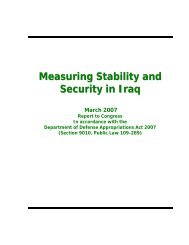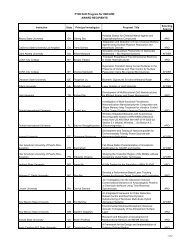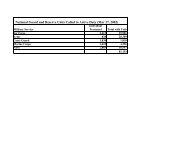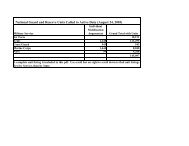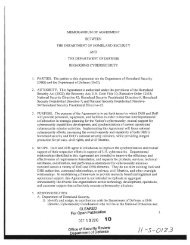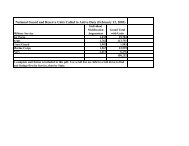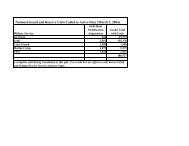Report - United States Department of Defense
Report - United States Department of Defense
Report - United States Department of Defense
Create successful ePaper yourself
Turn your PDF publications into a flip-book with our unique Google optimized e-Paper software.
UNCLASSIFIED<br />
2013 was variable across Afghanistan. There are currently four provinces facing 30-60 percent<br />
<strong>of</strong> the precipitation from 2011 to 2012, 12 provinces at 60-80 percent, nine provinces at 80-95<br />
percent, one province at 95-105 percent, three provinces at 105-120 percent, four provinces at<br />
120-140 percent and one province at just under 140 percent to precipitation accumulation over<br />
2011-2012 season. Overall, the precipitation levels and heavily fluctuating temperature means<br />
could shift crop success upward in 2013. Spring flooding is not expected to be significant<br />
compared to 2012.<br />
The impact <strong>of</strong> the lower total volume <strong>of</strong> crops in 2012 was <strong>of</strong>fset by higher market prices.<br />
Exceptions were potatoes, at 500,000 metric tons, pomegranates and wheat, which were all at or<br />
above average yields and therefore provided adequate income to those farmers. The outlook for<br />
the 2013 grain harvest also looks promising, as the planted area for winter crops was normal and<br />
MAIL and the UN “distributed approximately 20,000 metric tons <strong>of</strong> improved wheat seeds to<br />
households across the country.” Livestock conditions and prices were also higher in late 2012,<br />
supporting better nutritional variety and food security nationwide. Consequently, the overall<br />
outlook for agricultural livelihoods and food security appears positive through summer 2013.<br />
On February 12, 2013, the JCMB <strong>of</strong>ficially endorsed both National Priority Programs; NPP 1<br />
“National Water and Natural Resources Program” and NPP 2 “National Comprehensive<br />
Agriculture Production and Market Development Program.” Highlighted in NPP 1 is GIRoA’s<br />
need to establish irrigation associations at the community level that will largely be responsible<br />
for the operations and maintenance <strong>of</strong> all existing irrigation structures. The document continues<br />
by outlining the need for repairs to irrigation infrastructure, capacity building efforts, improving<br />
watershed management, extension <strong>of</strong> natural systems monitoring, and more. Highlights <strong>of</strong> NPP 2<br />
include the goal to improve sustainable agriculture production and productivity and increase on<br />
and <strong>of</strong>f-farm enterprises, contributing to food security, inclusive economic growth, and reduced<br />
dependency <strong>of</strong> subsistence farmers and laborers on narcotic crops. All <strong>of</strong> these improvements,<br />
enhancements, repairs, and local accountabilities will help lay the foundation for agricultural and<br />
sustainable economic growth in Afghanistan.<br />
Agribusiness development continues to be key driver to increasing overall economic growth and<br />
per capita GDP with the core rural population <strong>of</strong> Afghanistan. Many donor-funded programs are<br />
also focused on supporting core agribusiness creation, improving the agricultural value chain and<br />
increasing agricultural productivity and production. Additionally, the Agriculture Development<br />
Fund (ADF), which lends credit to small commercial farmers and agribusinesses, has reached a<br />
level where 89 percent <strong>of</strong> contracts are compliant with Sharia principles. ADF has been the<br />
foundation for the future creation <strong>of</strong> an Agricultural Bank, which will be overseen by MAIL.<br />
This evolution is improving the small-agribusiness and private-sector growth opportunities for<br />
rural farmers and encouraging foreign and national investment in agribusiness development.<br />
Agriculture’s long-term success depends on education, capacity building, and private sector<br />
development, as well as inclusion <strong>of</strong> women in the agriculture value chain. Agribusiness<br />
development, along with private and publicly funded vocational schools focused on agriculture,<br />
agribusiness, maintenance, and operations are closing the knowledge gap on agricultural<br />
advancements that were lost over the past 30 years. Proper education, better technological<br />
knowledge, improved inputs including irrigation, and value chain improvement will support<br />
158






